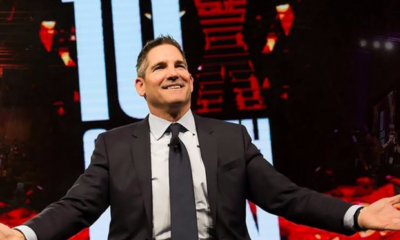Success Advice
7 Lessons You Can Learn from Grant Cardone’s book, Be Obsessed or Be Average

If you are a regular reader and viewer of business content, you probably know sales legend Grant Cardone. If not, he is on a mission to change that with his best-selling books, sales coachings, and motivational speeches.
However, he wasn’t always that successful. In fact, when he was 25, he had to overcome a drug addiction and a job he was neither successful or happy at. In his book Be Obsessed or Be Average, Cardone describes his journey from being obsessed with drugs to being obsessed with winning and success. It is a journey that he believes saved his life, and contains great advice for anyone that wants to become more successful at whatever they do.
Here are Grant Cardone´s tips for becoming obsessed with success:
1. Only you are responsible for your success
The truth is, no one is ever going to hand you success. There is no magic bullet or success pill that you can use to suddenly become successful. Instead, success comes from hard work, consistently repeated over time. If you are not where you wanted to be at this stage in your life, chances are that you haven´t been committed enough to make your dreams come true.
“True domination and true obsession, starts with dominating yourself, not others.” – Grant Cardone
2. If you can, you must
Ever since starting his transformation to one of the most successful salespeople in the world, Cardone saw his own success not just as a nice wish, but his duty and responsibility. In fact, he believes that success is your responsibility not just because of you, but also your family and the people depending on you.
Your spouse, your children, and your friends all deserve to have the best possible version of you in their lives, both in financial and any other terms. Once you start acting like success is your duty and not just something that would be nice, you will find yourself getting obsessed with becoming the best you.
3. There is no such thing as part-time obsession
When you are truly obsessed, there are no breaks. You are not just obsessed Monday through Thursday and then slowly change into weekend mode to forget about the workweek. You are not just obsessed when you feel good and everything is going in your favour. You are obsessed all the time!
Now, that doesn’t mean that you can´t take a day off and have to work 15 hours a day without ever taking a break (unless, of course, you are Grant Cardone), but rather that you constantly need to be obsessed with getting better. Whatever you do, make sure you are present in the moment and give it your best. Whether that is a date night with your spouse or playing with your kids, become obsessed with being the best you in everything you do.
4. You don’t need to like what you do to love what you do
This might sound contradictory at first, but let me explain. Even when you are living your purpose in life and do what you love, there will be many things that you may hate about it. Whether you dread making phone calls or answering emails, those are necessary parts of living your purpose every day.
Recognize that you may not like everything you do on a daily basis, but it still allows you to live your purpose and do what you love. Instead of getting frustrated about the things you hate doing, think of all the great things they allow you to do! Ask yourself, “How does doing this allow me to serve my purpose in a bigger way?”
5. Feed the beast every day
To me, one of the most important takeaways from his book was Cardone´s obsessive focus with goals: Writing them, reading them, and imagining them all day long. When he was starting out as a salesman, Cardone realized that he was losing focus and obsession too easily, so he decided to eat, breath, and sleep his goals.
This obsessive focus on what he wants to create in his life and how to get there allowed him to outwork anyone else and become one of the greatest salespeople alive. How you can use that? Write your goals down every day both in the morning and evenings, visualize your future, and get obsessed with winning every day!
6. Track your progress every day
One of the best ways to motivate yourself into action is by keeping track of how you are doing. When you set your goals and then track your progress every day, you will soon notice whether you are on your way to reaching them or not.
The great thing about writing down your progress is, you can see what you are doing on a daily basis in black and white, no excuses. If you determined that you have to make 20 sales calls a day to reach your goal but find yourself doing only 17, you know you are slacking off.
If you said you would run 40 miles this week but by Saturday you have still only run 20 miles, you see that you are failing. This might cause some emotional pain in the short term when you realize that you are actually not doing whatever it takes and need to step it up, but will save you lots of long term pain because you won´t ever set a goal without taking the necessary actions anymore!
“The average call me obsessed. The successful call me for advice.” – Grant Cardone
7. Dominating starts with dominating yourself
Whatever you want to create in life, there is only one person holding you back: You! Your thoughts, emotions, beliefs, and attitudes all determine your actions, which in turn create your results. If you want better results, start by working on your mindset and mastering your thoughts and emotions on a daily basis.
Almost every great success story on this earth has been attributed to a change in mindset. So if you want to dominate your life, start by dominating yourself – your thoughts, beliefs, and actions!
What are some ways you grow towards greatness everyday? Leave your thoughts below!
Did You Know
How Skilled Migrants Are Building Successful Careers After Moving Countries
Behind every successful skilled migrant career is a mix of resilience, strategy, and navigating systems built for locals.

Moving to a new country for work is exciting, but it can also be unnerving. Skilled migrants leave behind familiar systems, networks, and support to pursue better job opportunities and a better future for their families. (more…)
Life
10 Research-Backed Steps to Create Real Change This New Year
This New Year could finally be the one where you break old patterns and create real, lasting change.

Every New Year, we make plans and set goals, but often repeat old patterns. (more…)
Change Your Mindset
The Silent Skill That Makes People Respect You Instantly
What truly earns respect and why most people go about it the wrong way

Everybody craves respect but not everyone earns it. Some people believe that a title, years of experience, or a position of authority automatically entitles them to respect. (more…)
Entrepreneurs
The Essential Skills Every Entrepreneur Needs In 2026
Success in the digital age isn’t about luck. It’s about mastering the skills that separate dreamers from doers.

When I was 22 years old, I started my first side hustle as a ghostwriter. (more…)
-

 Shift Your Mindset4 weeks ago
Shift Your Mindset4 weeks ago11 E’s That Define Every Great Leader And Why Most People Miss Them
-

 Did You Know3 weeks ago
Did You Know3 weeks agoThe Success Patterns You Inherited (And Didn’t Notice)
-

 Entrepreneurs3 weeks ago
Entrepreneurs3 weeks agoThe Essential Skills Every Entrepreneur Needs In 2026
-

 Business4 weeks ago
Business4 weeks agoThe Hidden Money Pit in Your Operations (and How to Use It)
-

 Change Your Mindset2 weeks ago
Change Your Mindset2 weeks agoHow to Turn Your Mind Into Your Greatest Asset (Instead of Your Enemy)
-

 Change Your Mindset2 weeks ago
Change Your Mindset2 weeks agoThe Silent Skill That Makes People Respect You Instantly
-

 Life1 week ago
Life1 week ago10 Research-Backed Steps to Create Real Change This New Year
-

 Tech1 week ago
Tech1 week agoWhat’s in a Name? How to Get Your Domain Right


























1 Comment